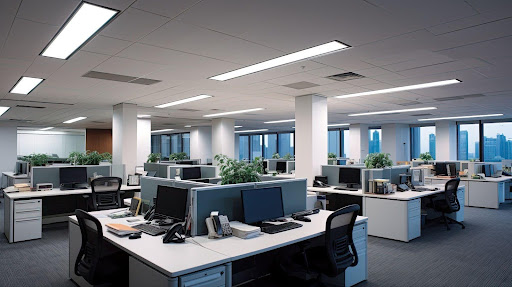A well-designed office isn’t just about aesthetics; it plays a crucial role in employee well-being, efficiency, and overall workplace satisfaction. Creating your dream office involves designing a functional and inspiring workspace that meets your vision. Additionally, engaging in cost efficient renovations is essential to maximize value while minimizing expenses, ensuring quality work that is both effective and financially sensible. Two of the most impactful design elements in any office renovation are color schemes and lighting, as they directly influence mood, concentration, and energy levels.
Whether you’re designing a modern workspace from scratch or revamping an existing office, this guide will walk you through the best color and lighting strategies to create a functional and inspiring environment.
Choosing the Right Color Scheme
Interior design does more than just decorate a space; it evokes emotions, influences behavior, and shapes the atmosphere of a workplace. Selecting the right color scheme can help promote productivity, creativity, and focus among employees.
1. How Colors Affect Workplace Mood and Performance
Here’s a breakdown of how different colors influence office environments:
- Blue: Known for its calming and stabilizing effect, blue enhances focus and mental clarity, making it ideal for corporate offices, financial institutions, and tech firms where deep concentration is required.
- Green: Associated with balance and tranquility, green helps reduce stress and eye strain, making it perfect for spaces where employees spend long hours, such as co-working offices and libraries.
- Yellow: A bright and energetic color, yellow stimulates creativity and positivity, making it a great choice for marketing firms, design studios, and brainstorming rooms.
- Red: Red is bold and stimulating, increasing heart rate and energy levels. It’s best used as an accent color in high-energy environments like sales offices or gyms.
- Neutral Tones (Gray, Beige, White): These colors create a clean, modern, and professional feel. However, using too much gray or white can make an office look sterile or uninspiring, so it’s best to complement them with accent colors.
2. Best Color Combinations for Office Space Planning
Here are some recommended color palettes to enhance your office space:
- For a Productivity-Focused Office: Blue + White + Wooden Accents
- For a Creative Work Environment: Yellow + Gray + Pops of Green
- For a Relaxing and Balanced Space: Earthy Tones (Beige, Olive Green, Soft Browns)
Tip: Instead of painting entire walls in bold colors, use accent walls, furniture, or decorative elements to introduce color without overwhelming the space.
Optimizing Office Lighting for Maximum Efficiency
Lighting is one of the most overlooked aspects of office design, yet it has a significant impact on mood, energy levels, and productivity. Upgrading to energy efficient lighting not only reduces electricity costs but also improves overall operational efficiency. Poor lighting can cause eye strain, fatigue, and headaches, while well-planned lighting can boost alertness and focus.
1. Types of Office Lighting and Their Roles
A well-lit office should incorporate a combination of lighting types to support different tasks and activities. Glass work is an important element in office lighting, as it enhances natural light distribution and contributes to a modern aesthetic:
- Ambient Lighting: The main source of illumination that lights up the entire room. Examples include overhead LED panels, recessed lighting, and ceiling fixtures.
- Task Lighting: Focused lighting for specific tasks, such as desk lamps, under-cabinet lighting, or adjustable office lights. These help prevent eye strain and improve precision for tasks like reading or typing.
- Accent Lighting: Decorative lighting that highlights architectural features, artwork, or brand elements. Examples include wall sconces, pendant lights, and LED strip lighting.
2. Understanding Color Temperature (Kelvin Scale) for Artificial Lighting
Light color is measured in Kelvin (K), which determines whether a light appears warm, neutral, or cool.
| Kelvin Range (K) | Light Type | Best For |
| 2700K-3500K | Warm white | Lounge areas, break rooms (relaxing, cozy atmosphere) |
| 4000K-5000K | Cool white (neutral) | Workstations, meeting rooms (sharp, focused lighting) |
| 6000K-6500K | Daylight (bright blue-white) | Hospitals, industrial areas (high alertness, sterile) |
- 4000K-5000K (cool white) is ideal for most office settings because it mimics natural daylight, helping employees stay alert and focused without being too harsh.
- Warm white light (2700K-3500K) creates a softer, more relaxing ambiance, suitable for break rooms and lounge areas.
- Daylight (6000K-6500K) can feel overly harsh in an office and is typically used in hospitals or manufacturing settings where high visibility is essential.
Tip: Use dimmable lights or smart lighting systems that allow you to adjust brightness based on the time of day and work activity.
3. How to Maximize Natural Light
Natural light has been linked to higher productivity and better mental well-being. A free site visit can help assess natural light opportunities and provide tailored lighting solutions. Here’s how to optimize it in your office:
- Position desks near windows to allow employees to benefit from daylight exposure.
- Use sheer curtains or blinds to control glare without blocking light.
- Choose light-colored walls and reflective surfaces (such as glass partitions) to help distribute natural light more effectively.
Image alt text: Modern office with dim lighting and a city view at dusk
Furniture Selection: Functionality Meets Comfort
A beautifully designed office won’t be effective without ergonomic, adaptable furniture that supports employee health and productivity, which is a key aspect of office interior design.
1. Key Features of Ergonomic Office Furniture
- Adjustable Chairs: Look for chairs with lumbar support, adjustable height, and armrests to prevent back pain.
- Sit-Stand Desks: These promote movement and reduce the risks of prolonged sitting.
- Proper Desk Height: Ensure desks allow comfortable arm positioning while typing to prevent wrist strain.
2. Adaptability and Modular Design
Modern office spaces are becoming more flexible and multi-functional. Consider:
- Mobile Workstations: These are Desks and tables on wheels that allow for easy rearrangement.
- Multi-Purpose Furniture: Pieces like storage ottomans, foldable desks, and nesting tables that save space.
- Acoustic Panels and Dividers: To create semi-private work areas in open-plan offices.
Bringing It All Together: A Checklist for Your Office Interior Design
To ensure a smooth office transformation, it is crucial to approach your renovation project with a structured plan. Timely execution and quality workmanship are essential for successful renovation work.
- Choose a color scheme that aligns with your office’s function (e.g., calming, creative, or high-energy).
- Incorporate multiple lighting types (ambient, task, and accent) for a well-balanced workspace.
- Optimize natural light to enhance mood and energy levels.
- Select ergonomic furniture to improve comfort and productivity.
- Use modular and adaptable furniture for a flexible, future-proof office design.
Final Thoughts
A well-designed office is more than just a stylish space; it directly impacts productivity, creativity, and employee well-being. Choosing a reliable renovation company is crucial for achieving these goals. An experienced office renovation contractor plays a vital role in ensuring a successful office transformation.
You can create a workspace that enhances focus, energy, and comfort by choosing the right colors, incorporating effective lighting, and investing in ergonomic furniture.
Whether you’re refreshing an existing office or starting from scratch, thoughtful design choices can transform your workspace into a place where employees feel motivated and inspired. With the right balance of aesthetics and functionality, your office can become a more productive, efficient, and inviting environment for everyone.































